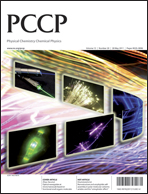We present results of experiments focused on emergent and cooperative dynamics in a system of two coupled flow-through stirred reaction cells with diffusion-like mass exchange and a strongly nonlinear chemical reaction between hydrogen peroxide and thiosulphate catalysed by cupric ions in diluted solution of sulphuric acid. Due to complex mechanism, in which a crucial role is played by hydrogen and/or hydroxide ions, dynamics in a single cell entail multiple stationary states, excitability and oscillations conveniently indicated by measuring pH. When coupled, the system shows a plethora of dynamical regimes depending on the coupling strength and flow rate. Under certain conditions both cells display dynamics close to that in the absence of coupling, but majority of the regimes are emergent and cannot be deduced from dynamics of decoupled reactors. The most prominent is a stationary state maintaining highly acidic values of pH in one of the reactors and weakly acidic in the other. When each cell is set to display excitability and the coupled system is externally perturbed, the cells may cooperate and transmit excitations elicited by pulsed perturbations in one cell to the other. Periodic pulses induce firing patterns marked by a various degree of propagated excitations and by being periodic or irregular.

You have access to this article
 Please wait while we load your content...
Something went wrong. Try again?
Please wait while we load your content...
Something went wrong. Try again?


 Please wait while we load your content...
Please wait while we load your content...